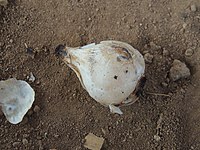Note: This is a project under development. The articles on this wiki are just being initiated and broadly incomplete. You can Help creating new pages.
Urginea indica
Urginea indica is a bulbous plant. First it will produce ing a flowering stem up to 45cm tall and then a rosette of leaves growing 15 - 45cm tall from the bulb, which is 6 - 8cm in diameter. The bulb is a common medicinal herb in India, where it is used in Ayurveda. It is normally gathered from the wild.
Uses
Skin disorders, Diaorrhea, Cardiac disorders, Chronic rhinitis, Chronic cough, Chronic pulmonary disorders, Respiratory diseases, Renal failure, Chronic renal failure, Amenorrhea, Dysmenorrhoea .[1]
Parts Used
Chemical Composition
It contains Entanoic acid, 4-oxomethyl ester or methyl levulinate, Butanone, 3-Hydroxy, Acetoin, Levulinate, Levulinic etc[2]
Common names
| Language | Common name |
|---|---|
| Kannada | Kadu Bili Irulli, Nari Irulli |
| Hindi | Junglipiyaj |
| Malayalam | Kaattu velangaay |
| Tamil | Narivangay |
| Telugu | Adavi tellagadda |
| Marathi | NA |
| Gujarathi | NA |
| Punjabi | NA |
| Kashmiri | NA |
| Sanskrit | Kolakanda |
| English | Wild Onion |
Properties
Reference: Dravya - Substance, Rasa - Taste, Guna - Qualities, Veerya - Potency, Vipaka - Post-digesion effect, Karma - Pharmacological activity, Prabhava - Therepeutics.
Dravya
Rasa
Katu, Tikta
Guna
Tikshna, Laghu
Veerya
Ushna
Vipaka
Katu
Karma
Prabhava
Hridya [4]
Habit
Identification
Leaf
| Kind | Shape | Feature |
|---|---|---|
Flower
| Type | Size | Color and composition | Stamen | More information |
|---|---|---|---|---|
| {{{5}}} |
Fruit
| Type | Size | Mass | Appearance | Seeds | More information |
|---|---|---|---|---|---|
Other features
List of Ayurvedic medicine in which the herb is used
Where to get the saplings
Mode of Propagation
[[:Category:Index of Plants which can be propagated by |]]
How to plant/cultivate
Commonly seen growing in areas
Photo Gallery
References
- ↑ Indian Medicinal Plants by C.P.Khare
- ↑ [Chemistry]
- ↑ Karnataka Medicinal Plants Volume - 2 by Dr.M. R. Gurudeva, Page No. 183
- ↑ Journal article - Chemical constituents of wild onion Urginea indica Kunth Liliaceae by M.N. Shiva Kameshwari, Department of Botany, Bangalore University.
- ↑ [Morphology]
- ↑ [Cultivation]
External Links
- Ayurvedic Herbs known to be helpful to treat Skin disorders
- Ayurvedic Herbs known to be helpful to treat Diaorrhea
- Ayurvedic Herbs known to be helpful to treat Cardiac disorders
- Ayurvedic Herbs known to be helpful to treat Chronic rhinitis
- Ayurvedic Herbs known to be helpful to treat Chronic cough
- Ayurvedic Herbs known to be helpful to treat Chronic pulmonary disorders
- Ayurvedic Herbs known to be helpful to treat Respiratory diseases
- Ayurvedic Herbs known to be helpful to treat Renal failure
- Ayurvedic Herbs known to be helpful to treat Chronic renal failure
- Ayurvedic Herbs known to be helpful to treat Amenorrhea
- Ayurvedic Herbs known to be helpful to treat Dysmenorrhoea
- Herbs with Leaf used in medicine
- Herbs with Root used in medicine
- Herbs with common name in Kannada
- Herbs with common name in Hindi
- Herbs with common name in Malayalam
- Herbs with common name in Tamil
- Herbs with common name in Telugu
- Herbs with common name in Sanskrit
- Herbs with common name in English
- Habit - Bulb
- Index of Plants which can be propagated by
- Herbs that are commonly seen in the region of Rocky savannah
- Herbs
